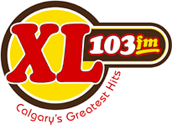CFXL-FM
CFXL-FM (103.1 FM, "XL 103") is a radio station in Calgary, Alberta. Owned by Stingray Group, it broadcasts a classic hits format. CFXL's studios are located on Centre Street Northeast just north of downtown Calgary, while its transmitter is located on Old Banff Coach Road in western Calgary.
 | |
| City | Calgary, Alberta |
|---|---|
| Broadcast area | Calgary, Alberta |
| Frequency | 103.1 MHz |
| Branding | XL 103 |
| Slogan | 70s, 80s and More |
| Programming | |
| Format | Classic hits |
| Ownership | |
| Owner | Stingray Group |
| Sister stations | CKMP-FM |
| History | |
| First air date | August 30, 2001 (as CIQX-FM) |
| Former call signs | CIQX-FM (2001-2008) |
| Technical information | |
| Facility ID | 6935 |
| ERP | 100,000 watts |
| HAAT | 342.2 metres (1,123 ft) |
| Transmitter coordinates | 51.0725°N 114.261°W |
| Links | |
| Webcast | Listen Live |
| Website | www.xl103calgary.com |

In fall 2014, the station was ranked #3 in the Calgary market according to the Fall 2014 PPM data report released by BBM Canada.[1]
History
The station officially began broadcasting on August 30, 2001, at 1:03 pm, with the call sign CIQX-FM and the brand name The Breeze. However, the station was rebranded on December 26, 2005, as California 103, a soft adult contemporary/smooth jazz format.
On March 3, 2008, at 3:00 pm, the station switched to its current classic hits/oldies format branded as "XL103". The last song played on "California 103" was "Like a Lover" by Emilie-Claire Barlow while the first song played on "XL103 FM" was "Crocodile Rock" by Elton John.
The station's license was originally awarded to Telemedia; prior to its launch, Telemedia's Alberta stations were sold to Newcap Radio, with Standard Broadcasting as minority shareholder until 2007. The station adopted its current call sign on June 5, 2008, shortly after the former CFXL-FM in High River changed its own call sign to CKUV-FM.
References
External links
- Official website
- CFXL-FM history – Canadian Communications Foundation
- Broadcasting Decision CRTC 2002-213
- CFXL-FM in the REC Canadian station database